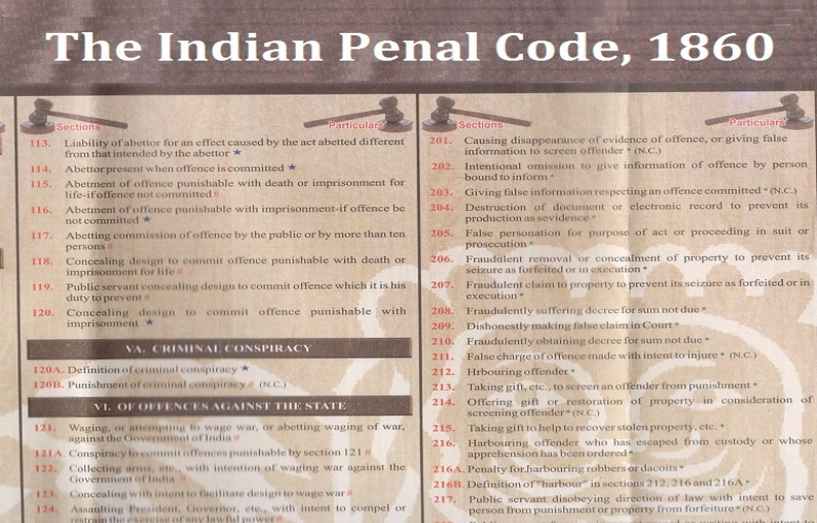
Introduction
- The Indian Penal Code was created in 1860 and is the country’s official criminal code. Its goal is to create a comprehensive penal law for the country. It is divided into 511 sections and 23 chapters, and it contains a list of crimes, as well as their definitions and penalties. Other Acts now supplement the IPC, which has been revised multiple times. Except for the state of Jammu & Kashmir, it has jurisdiction over the entire country. India’s official criminal code is the Indian Penal Code (IPC). It is a comprehensive code that aims to cover all aspects of criminal law. The code was developed in response to the suggestions of India’s first law commission, which was constituted in 1834 under the Charter Act of 1833 and chaired by Thomas Babington Macaulay. It went into effect in British India in 1862, during the early years of the British Raj. However, until the 1940s, it did not automatically apply in the Princely states, which had their own courts and legal systems. The Code has been revised several times since then, and it currently includes additional penal sections. The Indian Penal Code was inherited by the successor states of the British Indian Empire, the Dominion of India and the Dominion of Pakistan, where it is still in use as the Pakistan Penal Code. The code remained in effect after Bangladesh was separated from Pakistan. The Code was also adopted by British colonial authorities in Colonial Burma, Ceylon (now Sri Lanka), the Straits Settlements (now part of Malaysia), Singapore, and Brunei, and it still serves as the foundation for their criminal codes.
History Of The Indian Penal Code

In 1834, the Indian Penal Code was drafted by the First Law Commission, which was chaired by Thomas Babington Macaulay. The Napoleonic Code and the Louisiana Civil Code of 1825 were also used to create elements. In 1837, the first definitive draught of the IPC was presented to the Governor-General of India in Council; however, the draught was later changed. In 1850, the drafting was completed, and in 1856, it was presented to the Legislative Council. The draught was only passed into law in 1860, and it went into effect on January 1, 1862. The First Law Commission, chaired by Thomas Babington Macaulay, drafted the first draught of the Indian Penal Code. The proposal was based on a straightforward codification of English law, with components borrowed from the Napoleonic Code and the Louisiana Civil Code of 1825.
The initial draught of the Code was given to the Governor-General in Council in 1837, but it took another two decades for changes and amendments. In 1850, the entire code was completed and delivered to the Legislative Council in 1856. Due to the Indian Revolt of 1857, it took longer to be enacted into British Indian law. After several changes and amendments by Barnes Peacock, who would go on to become the first Chief Justice of the Calcutta High Court, the code went into effect on January 1st, 1860. For the most part, until the arrival of the British, India’s penal law was Muhammedan law. Although the East India Company did not interfere with the country’s criminal law for the first few years of its administration, and although the Company did so for the first time in 1772, during Warren Hastings’ administration, and the British Government did alter the Muhammedan law from time to time until 1861, the Muhammedan law was undoubtedly the basis of the criminal law until 1862, when the Indian Penal Code came into effect, the Muhammedan law was undoubtedly the basis of the criminal law until 1862The administration of Muslim criminal law in India lasted for a long time and gave rise to a large number of terminology in the Indian legal lexicon.
Objective
- The purpose of this Act is to provide India with a general penal code. The Act does not repeal the penal laws in force in India at the time it was enacted, which was not the original goal. This was done because the Code does not cover all of the offences, and it was probable that some offences that were not intended to be exempted from legal repercussions were nevertheless left out. Despite the fact that this Code consolidates all of the legislation on the issue and is exhaustive in the areas in which it announces the law, many more criminal acts governing specific offences have been enacted in addition to it.
Brief About Indian Penal Code

1. Crimes Against The Human Body
These offences are covered by Chapter XVI of the Code, which includes sections ranging from Section 299 (culpable homicide) to Section 377 (unnatural offences).
The chapter covers a wide range of crimes against the human body, from the most minor, such as simple bodily harm or assault, to the most serious, such as murder, kidnapping, and rape.
2. Crimes Against Property
- These offences are defined and punished under Chapter XVII and include Sections 378, which defines stealing, and Section 462, which specifies the penalty for breaking upon the entrusted property. Theft, extortion, robbery, dacoity, deceit, and forgery are just a few of the crimes addressed in this chapter.
3. Crimes Against Public Tranquillity
- Chapter VIII, which covers Sections 141 to 160, contains definitions and penalties for this category of offences. This chapter outlines the acts that are considered illegal in nature because they disrupt or destroy public order and serenity. Offenses such as being a member of an unauthorized assembly, rioting, and affray are covered in this chapter.
4. Offences Against The State
- Sections 121 to 130 of Chapter VI, which deals with such offences, are among the most stringent criminal provisions in the entire code. This includes Section 121’s offence of waging war against the state and Section 124A’s much-discussed, criticised, and abused offence of sedition. The offence defined in this section has been heavily criticised because it was used by the British to punish numerous freedom fighters; it was also used post-independence to suppress government opponents, and it continues to be used now, which is why many experts urge repealing it.
5. General Exceptions
- The broad exceptions, which are unusual situations in which the perpetrator can avoid criminal liability, are enumerated in Sections 76-106 (Chapter IV). The Right to Private Defense is a good example of this (Section 96-106). Insanity, necessity, consent, and acts of minors under a specific age are among the other ideas explored in this chapter.
Debated Provisions Of The IPC
- In general, the IPC has been successful in prosecuting and punishing persons who commit the offences outlined in the Code, but certain additional articles, such as Sedition, have been subject to repeated scrutiny. The following are some of these provisions:
1. Unnatural Offences-Section 377
- Consensual sexual acts between consenting individuals of the same sex were punished under this section, among other things. With the passage of time, various voices campaigned for the repeal of the law that criminalises homosexuality. Finally, in the case of Navtej Johar, the Supreme Court complied and decriminalized the portion of this Section that penalized voluntary conduct of this sort.
2. Attempt to Commit Suicide – Section 309
- Attempting suicide was punishable by up to a year in this section. The Law Commission has long recommended that attempted suicide be decriminalized by repealing Section 309 of the Criminal Code. However, despite the fact that the usage of the provision has been reduced since the Mental Healthcare Act of 2017, the amendment to this effect has not been carried out. A person who attempts suicide is presumed to be under severe stress under the non-obstante clause in Section 115(1) of the Mental Healthcare Act, 2017, and such a person is not to be penalized under Section 309 IPC. However, reports of the usage of Section 309 IPC are not uncommon and may be found in practically every section of the country. As a result, it is critical that the police authorities be aware of the situation.
3. Adultery – Section 497
- This section was criticized for portraying a woman as the private property of her husband and for imposing moral precepts on married couples. The Supreme Court finally struck down this section in September 2018 when it decided the case of Joseph Shine v. Union of India. The Code also allows for the death penalty to be applied to specific crimes, such as murder, rape, and waging war against the government. Several human rights organizations have called for the death sentence to be abolished, claiming evidence that the punishment is not only arbitrary but also violates the offender’s basic human rights.
Review Of The Indian Penal Code Post-independence

- The fact that the IPC has endured and thrived for over 160 years says volumes about its success as a high-status penal code. However, it has been unable to eliminate some of its legislation that reeks of colonialism, such as sedition, throughout the years. While calling for criminal justice changes, the Malimath Committee report has given Parliament the opportunity to update the Code and other criminal statutes. It has been 17 years after the report was submitted, and no tangible action has been made in this regard. It’s past time for the legislature to step in and update the Code to reflect present circumstances rather than the era of British colonialism. When the Supreme Court intervenes and strikes down laws, it reflects poorly on the legislature because it is the legislative’s obligation to do so in the first place. Despite the fact that the 42nd report of the law commission in 1971 recommended a full revision, no major revision has been conducted — the amendment bills of 1971 and 1978 lapsed due to the dissolution of the Lok Sabha. As a result, it has undergone numerous ad hoc and reactive revisions. The ‘Master and Servant’ aspect of the Indian Penal Code has been underlined, with several of the clauses having no place in Independent India. The following are some of the aspects that require reform and review:
The sedition statute, which was enacted in 1898, has to be revisited.
Blasphemy should have no place in a liberal society, which is why Section 295A, which was enacted in 1927, ought to be repealed.
In 1913, a criminal conspiracy was deemed a serious offence. The offence is problematic since it was added to the statute to cope with political conspiracies by colonial officials.
The notion of constructive culpability is taken to overly harsh lengths under Section 149, which deals with unlawful assembly.
The code’s sexual offences illustrate patriarchal beliefs and Victorian morality. Though the outdated crime of adultery grants the husband sole property rights over his wife’s libido, it provides no legal protection for the wife to obtain a similar monopoly.
Overview
The Indian Penal Code’s goal is to define what is proper and wrong, as well as the penalties for doing those wrongs. In criminal law, the “intention” of committing the crime is extremely important in determining the offense’s responsibility.
In most cases, there are five phases to committing a crime:
- motive
- intention
- preparation
- Commission
When someone goes beyond the stage of preparation and seeks to carry out the criminal conduct, they are held liable.
The Indian Penal Code begins with an introduction, which includes explanations and exclusions, before laying out a broad variety of offences.
When someone goes beyond the stage of preparation and seeks to carry out the criminal conduct, they are held liable.
The Indian Penal Code begins with an introduction, which includes explanations and exclusions, before laying out a broad variety of offences.
The Indian Penal Code (IPC) has a broad categorization of offences.
- Murder, culpable homicide that does not amount to murder, kidnapping, and other crimes against the body
- Theft, dacoity, burglary, and other property crimes
- Riots and arson are examples of crimes against public order.
- Cheating and counterfeiting are two types of economic crimes.
- Rape, dowry killing, abuse by husbands and relatives, molestation, sexual harassment, and the importation of girls are all crimes against women.
- Child rape, kidnapping, abduction, selling and buying of girls for prostitution, abetment to suicide, infanticide, and foeticide are all crimes against children.
- As previously stated, the Indian Penal Code (IPC) governs a large portion of Indian criminal law. It enumerates a number of typical criminal charges. For example, it defines murder, theft, assault, and a variety of other offences, as well as the proper punishments for each of them. Section 378 of the Indian Penal Code, for example, defines the crime of “stealing.” It states that if a person deceitfully plans to take any movable property out of a person’s possession without his or her agreement and moves such property, he or she is guilty of stealing. The mere intent to take someone’s property without actually carrying out the process is not considered theft. The Act also includes an explanation of the various provisions. These explanations go over the sections in further detail. Section 378, for example, specifies five definitions for the term “theft” –
Explanation 1- A object is not subject to theft as long as it is attached to the earth and is not mobile property; however, as soon as it is removed from the earth, it becomes susceptible to theft.
Explanation 2- A theft may occur when a move is affected by the same act that affects the severance.
Explanation 3- A person can cause something to move by removing a barrier that is preventing it from moving or by separating it from anything else, in addition to moving it.
Explanation 4- A person who, by any means, causes an animal to move is said to move that animal, as well as anything that is moved by that animal as a result of that motion.
Explanation 5- The consent referred to in the definition can be expressed or implied, and it can be provided by the person in possession or by someone with express or implied authority for that purpose.
- Section 379 of the Penal Code defines theft as a crime punishable by imprisonment for up to three years, a fine, or both. Depending on the seriousness of the offence, different offences have varying sanctions. Murder, for example, carries a penalty of either death or life imprisonment.
Conclusion
- The Indian Penal Code is organised in this manner. The definition of the infraction is established first, followed by the penalty for the offence. Other specific legislation, such as the Information Technology Act, the Prevention of Corruption Act, the Indecent Representation of Women Act, the Narcotics and Psychotropic Substances Act, and others, permit categorization and punishment of criminal offences in addition to the Indian Penal Code. The term just hints at the nature of the offence. It doesn’t say what we should do if our property is taken, or who we should seek justice from. Or, in this case, what can the cops do? To put it another way, the Indian Penal Code solely addresses substantive criminal law, not procedural criminal law. The Criminal Procedure Code of 1973 defines procedural law.
Top 13 Interesting Facts About Indian Penal Code
Some of the noteworthy facts concerning the Indian Penal Code that spring to mind are:
The code is also known as the British-imposed Indian moral code since many of the offences are based on the morals popular in England during the 19th century.
It provides a comprehensive handbook on crime, from conception through execution and punishment. All aspects of the crime are discussed, including the planning, the attempt, the execution, and the consequence of the execution, i.e. punishment. It’s worth noting that some offences are punished even if execution is attempted but fails.
It discusses its applicability in great detail, just like any other legislation. It has jurisdiction both within and outside of India. Perhaps this is why the phrase “kanoon ke haath lambhe hote hai” is frequently used (the law has long hands to catch the criminal).
The definitions of the terminology used in legislation are usually found in the second section. IPC is likewise quite thorough in this area, dedicating a chapter to it as general explanations. The definitions are straightforward, simple, and concise. That is why, when dealing with the definitions of terminology used in them, much later legislation significantly depends on it and simply declares “as defined in IPC.”
304A Causing death by hasty and careless conduct – two years in jail, a fine, or both.
304B Dowry Death – Imprisonment for a period of not less than 7 years but not more than life.
307 Murder attempt – ten years in jail and a fine.
When is it acceptable to be forgiven for committing a crime? The answer may be found in the code’s generic exceptions chapter.
The code makes abetment criminal, which means that not only the weapon-wielding hand but also the forces driving it are penalized. As a result, all those sophisticated persons participating in crime behind the scenes will not be spared.
The code covers crimes done either alone or in collaboration with a group of persons, either directly or indirectly. Conspiracies are therefore avoided.
Offenses against the state, currency, decency, morals, peace and tranquillity, public officials, armed forces, human body, and property are all detailed. However, the customary procedure in each of these sections is to specify the first offence before prescribing a punishment. However, while a maximum penalty is usually given, leaving the court with the power to impose anything from the minimum to the maximum, in rare circumstances, minimum punishment is mandated, removing this discretion.
The section in which a person is charged with an offence is also the part in which the punishment is specified. Murder, for example, is defined under section 300 of the IPC, yet a criminal is convicted under section 302.
A failed effort is treated as a half-completed offence and is penalized with half the penalty stipulated for the offence.
Some FAQs Or Also Ask Question
How many IPC are there in the Indian Penal Code?
Indian Penal Code, 1860 Sections in IPC (576 total) Including amendments and additions.
Who drafted IPC 1860?
The draft of the Indian Penal Code was prepared by the First Law Commission, chaired by Thomas Babington Macaulay in 1835 and was submitted to Governor-General of India Council in 1837.
What is the meaning of IPC 1860?
The Indian Penal Code (IPC) is the principal criminal code of India that defines crimes and provides punishments for almost all kinds of criminal and actionable wrongs. The IPC extends to the whole of India except the states of Jammu and Kashmir and is an extensive law that covers all the substantive aspects of criminal law from nuisance at public places to murder, rape, dacoity, etc.
What is IPC punishment?
The death sentence is a punishment which is sanctioned by the government and ordered by the court where a person is put to death for a crime acted by him. It is also referred to as ‘Capital Punishment’. The act of carrying out such practice is called execution. As per the Amnesty International survey, the report on as of July 2018 is 56 countries retain capital punishment and 106 countries have completely abolished capital punishment for all crimes. In India, the death penalty is given by the method of hanging. The other ways through which death sentences executed at world scenarios are stoning, sawing, blowing from a gun, lethal injection, electrocution, etc.
Who made the Indian Penal Code?
The draft of the Indian Penal Code was prepared by the First Law Commission, chaired by Thomas Babington Macaulay in 1835 and was submitted to Governor-General of India Council in 1837.






